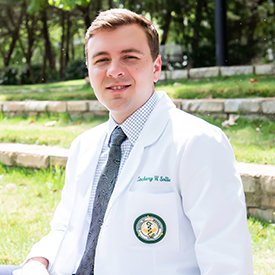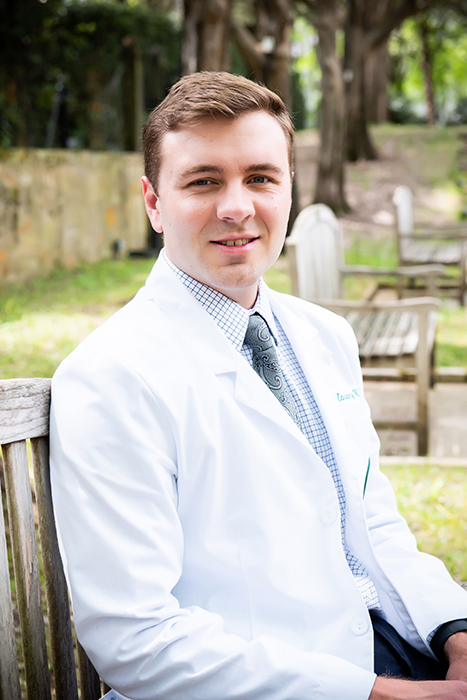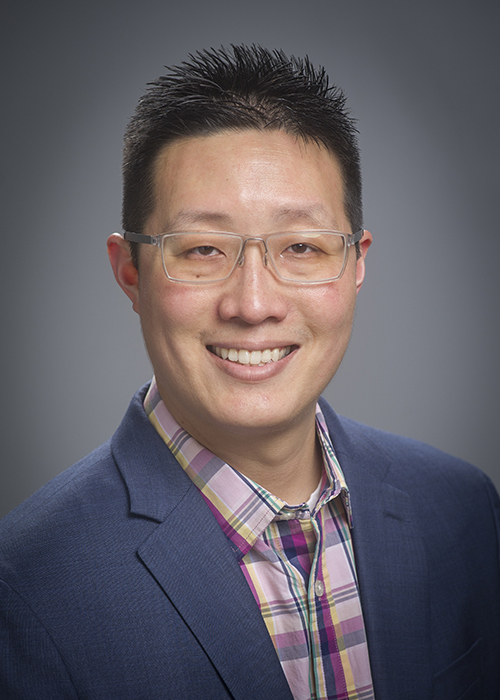 Last fall, when then-third-year Montgomery Regional Medical Campus medical student Zachary Sollie first met Thomas Jones while rotating through Medical Outreach Ministries in Montgomery, Jones was experiencing uncontrollable movements in his extremities, especially his legs. The physicians suspected an underlying neurological condition, but which one? The symptoms fit Huntington’s disease, but the disease is relatively rare and always hereditary. Jones had no known family history.
Last fall, when then-third-year Montgomery Regional Medical Campus medical student Zachary Sollie first met Thomas Jones while rotating through Medical Outreach Ministries in Montgomery, Jones was experiencing uncontrollable movements in his extremities, especially his legs. The physicians suspected an underlying neurological condition, but which one? The symptoms fit Huntington’s disease, but the disease is relatively rare and always hereditary. Jones had no known family history.
Moreover, the clinic—which provides free medical care to uninsured and underserved patients in the area—typically serves patients with more common conditions such as diabetes or hypertension, explains Richard Cyrus, M.D., a retired cardiothoracic surgeon who volunteers at the clinic. “It’s not every day that we have something that’s totally undiagnosed and outside of my knowledge,” Cyrus says.
Sollie, however, had not only studied Huntington’s recently, but he had learned about it from an expert—Victor Sung, M.D., an associate professor of Neurology who serves as director of the UAB Huntington’s Disease Clinic. Sollie recognized Jones’ symptoms as classic Huntington’s from videos Sung had shown of Huntington’s disease patients. He also remembered from Sung’s lectures that patients may not present with a family history, because in some cases the history is unknown to the patient.
 Zachary Sollie “Huntington’s is one of those diseases that is very textbook, where we learn about it in the classroom and then aren’t likely to see it in real life,” Sollie says. “That’s where my role as a student came into play, because I encountered it within a year of studying it.”
Zachary Sollie “Huntington’s is one of those diseases that is very textbook, where we learn about it in the classroom and then aren’t likely to see it in real life,” Sollie says. “That’s where my role as a student came into play, because I encountered it within a year of studying it.”
Huntington’s disease causes progressive degeneration of nerve cells in the brain, resulting in cognitive disorders along with loss of motor control. Sollie acknowledges it is a difficult prognosis for patients to hear. However, as a student of Sung’s, Sollie was able to do more than pinpoint the diagnosis; he also knew to recommend that Jones be referred to Sung’s clinic, which offers a highly specialized, comprehensive level of care for these patients.
“We’re able to provide hope on multiple levels,” says Sung, who has served as director of the clinic since 2011. “There are things we can do in our clinic that will help Mr. Jones today, but also, because of where the research is, there is real hope. There are real gene-silencing trials ongoing now and more coming.”
The UAB Huntington’s Disease Clinic is the only one of its kind in Alabama and Mississippi to be sponsored by the Huntington’s Disease Society of America. That designation reflects a level of comprehensive care that includes not only medical care but physical, occupational, and speech therapy; genetic testing; and access to a psychiatrist, nutritionist, and social worker. For a patient like Jones, pairing the relief of finally having a diagnosis with access to a clinic offering tangible help can be a life changer.
“There are multiple FDA-approved treatments for Huntington’s disease, and I think a lot of people in the community are not aware of those,” Sung says. “We are very familiar with those treatments and prescribe them, so we see our patients get better. Their quality of life is better.”
Jones is now being treated in the clinic and receiving medication. A social worker is even working to help him get disability benefits, and Sung says the family has expressed their gratitude to “Zach and to UAB, for the innumerable ways UAB’s resources have completely transformed their family’s life in just a few short weeks.”
 Victor SungIn a letter circulated among School of Medicine leadership, Sung wrote about the significance of Sollie’s contribution to Jones’ case: “I think this is such a fabulous story of bridging pre-clinical teaching to enhancing clinical care and transforming the lives of real patients.”
Victor SungIn a letter circulated among School of Medicine leadership, Sung wrote about the significance of Sollie’s contribution to Jones’ case: “I think this is such a fabulous story of bridging pre-clinical teaching to enhancing clinical care and transforming the lives of real patients.”
While Sollie does not plan to pursue neurology—he is hoping to go into cardiothoracic surgery—he says he feels gratified to have played a role in helping Jones get the care he needs. “It was very cool to be involved in this case and see the textbooks come to life,” he says. “A big thing in (Jones’) scenario for me is that it really hammers home the patient-centered care, patient-centered approach taught to us in our training. The patient was distressed about these symptoms and didn’t have an answer. So being able to take the knowledge and help this patient with a diagnosis, and connect him with the resources he needs, it was great to see that pan out.”
By Rosalind Fournier